How developer platforms can triumph over the three most common product-led growth roadblocks
A playbook of eight proven strategies to convert unpaid users, expand accounts, and push upmarket.
The power of product-led growth is undeniable. Time and time again, top CEOs have attributed their scale and success to a bottoms-up strategy. Product-led companies tend to experience accelerated growth, best-in-class unit economics, and strong valuation multiples compared to peers. This go-to-market approach has gained even more momentum in recent years, driven by strong macro tailwinds. For one, the rise of distributed and remote workforces has pushed more decision-making power away from the top and into the hands of end-users. This and other factors have led the cumulative market capitalization for product-led growth companies to multiply more than 100x in the last six years.
As investors, nothing makes us smile harder than when we see developers shout from the virtual “rooftops” about tools they use on platforms such as GitHub, Hacker News, ProductHunt, and Twitter. (In fact, these examples of effusive customer love and amazing user experiences often play a driving role in our investment decisions.) While the upsides of a product-led go-to-market strategy are widely known and celebrated, what is less often talked about is the challenges associated with embracing this strategy. Getting it right is a lot harder than it may seem.
Across many different industries, verticals, and stages, we see teams facing similar challenges that inhibit the full potential of their growth motion. The following are the most common points of friction:
- Converting enthusiastic users into paying customers.
- Expanding share of wallet after landing an account.
- Pushing upmarket and out-bounding into enterprise.
If your company is experiencing issues like these, don’t fret! Many others have navigated these challenges and scaled to incredible heights while staying true to their product-led roots. Companies such as Auth0, HashiCorp, LaunchDarkly, PagerDuty, and Twilio are all examples of beloved developer-centric platforms that have successfully bridged the gap between exponential end-user momentum and strong commercialization.
In this playbook, we’ll share eight strategies from these developer-first companies to overcome common obstacles and achieve product-led success.
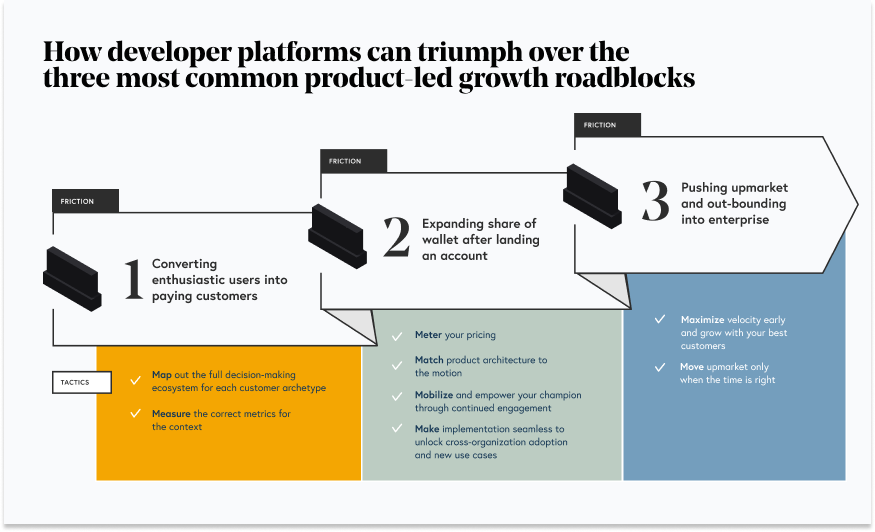
Friction point 1: Converting enthusiastic users into paying customers
Tactic A: Map out the full decision-making ecosystem for each customer archetype
Struggling to monetize users is a common difficulty, not only amongst startups using a freemium or free trial model, but also from open-core software companies, where strong adoption and community metrics don’t always translate easily into commercial momentum. This might seem odd since the whole premise of product-led growth is based on individual end-users having the power to make procurement decisions. If the users and buyers are one and the same, then why is monetization so hard?
While macro trends have helped tip the balance of purchasing power toward the end-user, it is important to keep in mind that the end-user is still a unit within an organization’s broader procurement ecosystem. That’s why it’s essential to map it out and understand each stakeholder intimately.
Every organization’s decision-making fabric is unique, often due to company size or corporate culture, with power concentrated in many different parts of the ecosystem. Along with users of the product, other stakeholders in this ecosystem include:
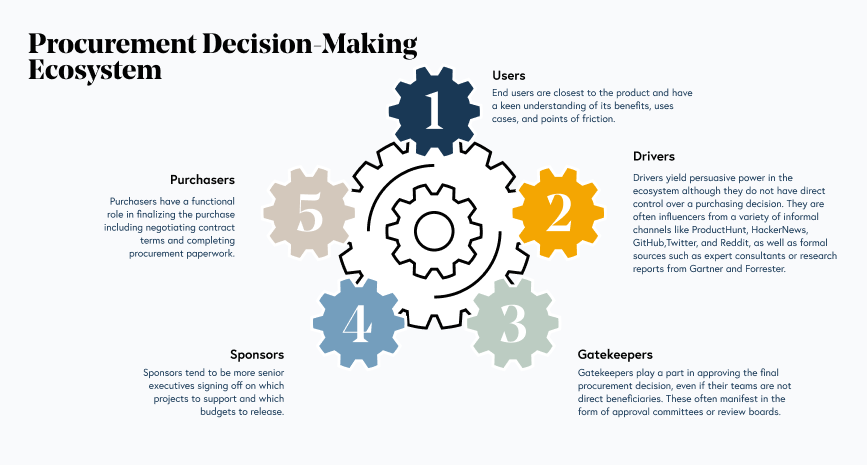
- Drivers hold persuasive power in the ecosystem although they do not have direct control over a purchasing decision. They are often influencers from a variety of informal channels like ProductHunt, HackerNews, GitHub,Twitter, and Reddit, as well as formal sources such as expert consultants or research reports from Gartner and Forrester.
- Gatekeepers, who play a part in approving the final procurement decision, even if their teams are not direct beneficiaries. These are often approval committees or review boards.
- Sponsors, who tend to be senior executives signing off on which projects to support and budgets to release.
- Purchasers, who have a functional role in finalizing the purchase including negotiating contract terms and completing procurement paperwork.
Each stakeholder has distinct aspirations and may be at different junctions along their awareness journey of your product. The most strategic developer-centric companies have a clear understanding of customer decision-making ecosystems, including how each unit interacts with their end-user champion, where power is concentrated in the system, what value proposition resonates the best with each stakeholder, and who needs to be convinced to tip the scales in favor of their champion. Even before any signs of friction appear, developer-centric companies are wise to hypothesize about which stakeholders are most likely to cause a bottleneck and pre-empt this by addressing specific concerns.
For instance, many developer tools targeting highly-regulated industries require some sort of endorsement or buy-in from “gatekeepers” within a company’s corporate compliance or security division. Once these decision-making relationships are mapped, a startup can then hyper-tailor content marketing to specific security layer concerns, or introduce webinar programming targeted at certain roles (e.g. Chief Security Officer). Some of the best product-led companies have such a firm grasp of these dynamics that they go one step further to identify alternative budget holders to unlock within the ecosystem (e.g. digital transformation budget as well as engineering budget) and lay the groundwork for their champion to take the path of least resistance for spending approval.
Tactic B: Measure the correct metrics for the context
There are innumerable metrics a company could track, and focusing on the wrong ones might send false signals about product-market fit. It may be very tempting to look only at traditional sales and marketing metrics like total leads or free-to-paid conversion rates, since these are tangible performance indicators. However, it is essential to recognize that strong user engagement is the key to success in a product-led motion.. Without it, the product-led flywheel will not spark, and it will be difficult to develop vocal end-user champions.
Actions speak louder than words, and similarly actual user behavior reveals volumes about how engaged customers are with your product. It’s prudent to track and set specific KPIs around user actions and product engagement metrics such as DAU/MAU ratio and time per session. You can also drill down deeply into individual behavior and specific feature usage to see where engagement tends to drop off or pick up. Then you can take actions to either fix or amplify these points.
The product team at HashiCorp is a star example of data-driven decision-making—they track product metrics that are leading indicators for how successful they are at winning the hearts and minds of developers. We’ve even seen some product-led startups have product teams lead their monthly business reviews, focusing a significant amount of time on discussing engagement trends. Leveraging “growth” product managers are no longer solely the purview of consumer startups—product metrics-minded leaders are also on the rise within many B2B organizations.
Friction point 2: Expanding share of wallet after landing an account
Tactic A: Meter your pricing
The first law of Bessemer’s Developer Platforms Laws states that businesses have more pricing power when their value metric is granular and metered. We interview thousands of market participants and customers every year, and their feedback is unanimous. They love metered, usage-based pricing—not only because of its transparency, but also because it allows them to start at a low entry point and then scale up later.
A metered pricing model is an incredible complement to a product-led distribution strategy, since individual end-users can enter at a low cost and there are no limitations on the number of new users or seats. As a result, additional usage can be layered on organically without end-users needing to go through new approval or negotiation processes.
Usage-based pricing allows many top software companies achieve net retention above 100%, and without any sales team intervention. SendGrid, which showed strong signs of this trend when we first met the company back in 2011, achieved outstanding cohorted retention of 136% in month 12 and 186% in month 18 even from the company’s earliest days. PagerDuty showed a similarly gravity-defying expansion, with MRR growing by 260% by month 24 when we first partnered with them in 2014.
Tactic B: Match product architecture to the motion
Sometimes a lack of momentum to expand is caused by structural issues within a product’s architecture. Being a product-led organization does not simply mean using free trials or relying on word of mouth. The best developer-centric platforms have a product-led philosophy down to the core of the product’s architecture.
These role models adhere beautifully to Law 2 of our Developer Laws, which is that “well-designed developer platforms have natural upsell triggers inherent to the product.” They ensure that their product is purposefully built to capture the most value from a product-led motion by first drawing in a champion through an initial feature or platform wedge and then by organically enabling upsell through the product.
LaunchDarkly, whose thoughtful, multi-layered platform allows for flexibility with add-ons built on top of the core, is a prime example. Due to its product structure, LaunchDarkly is not only easily customizable, but the company is also able to capture value quickly across different layers of the value chain. PagerDuty is another exemplar of product architecture that supports a product-led growth motion. Their IT incident management platform was naturally built to maximize network effects and pull in adjacent business units beyond their initial champion’s team as alerts, notifications, and data accrue over time.
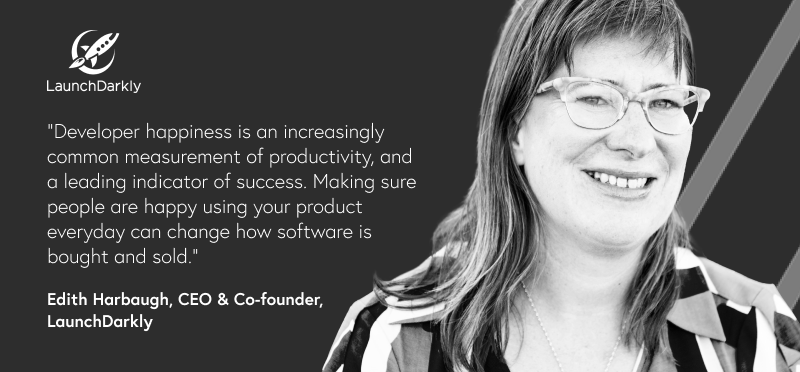
Tactic C: Mobilize and empower your champion through continued engagement
Another key tenet of our Developer Laws is that “developer mavens are usually the first and best marketing channel – their authentic evangelism drives adoption and sales.” This is perhaps the most important law for product-led companies, as end-user advocates are not just essential for initial adoption, but also for successful expansion. Just as top-down sales-led companies rely on enablement programs and training to improve rep productivity or renewal team effectiveness, it is equally important for product-led companies to activate and empower the initial champion after landing an account. It’s important to recognize the immense leverage you have through this end-user evangelist—they are akin to a front-line sales representative.
Product-led companies tend to have a culture of rich documentation, since they encourage self-service behavior from their end-users. A stellar example of this is Auth0, whose incredibly thorough and deep documentation stood out to us early on when we led their seed round in 2014. This was key to driving initial traction and was consistently cited as a top reason why developers would choose their platform. As a natural extension to a library of technical documentation, one very simple but effective way Auth0 equipped their champion with the tools to advocate within their organization was to add more collateral around new use case narratives.
Beyond content marketing, we have also seen others in the developer platforms space accomplish this same result through digital communities such as Tribe, Discord, and Slack forums as a place to curate content, keep champions up to date with new developments and connect prospects with other happy users.
Tactic D: Make implementation seamless to unlock cross-organization adoption and new use cases
“Developer platforms strive to be as frictionless as consumer products” is the Developer Law that drives many product-led companies as they aim to harness the power of delightful UI/UX to drive initial adoption. This principle does not just apply to intuitive usage, but to effortless implementation as well. There are now tens of thousands of APIs, microservices, and specialized integrations catering to every need. Enterprise architecture is becoming more complex, and even different teams within a single division might have different ecosystems. We expect this trend to continue in the foreseeable future. Not having flexible orchestration and customized, integrated functionality with existing infrastructure is often an impediment to cross-organization expansion even when a product is best-in-class in usability and features.
Just as consumer products can often be downloaded and installed with a click of a button, the best developer-centric platforms have evolved their implementation process to be as smooth and self-serve as possible in an organization-wide, multi-deployment environment to boost cross-team expansion beyond their initial champion. This is especially important in a bottoms-up expansion motion since there is no primary solutions engineering or implementation team for customers to lean on.
Cypress, the Javascript testing framework, illustrates this practice. When we first invested, we were blown away by the strong product feedback from so many developers who sought out a better open-source alternative to Selenium. On top of being a productivity gain, Cypress makes testing a delightful experience. With such a UI/UX philosophy as its foundation, Cypress has constantly evolved its implementation model as well to encourage enterprise-wide adoption and new use case expansion by accounting for different test syntaxes and building out more integrations.
Friction point 3: Pushing up-market and outbounding to enterprises
Tactic A: Maximize velocity early and grow with your best customers
A product-led growth strategy is predicated on using product momentum to reduce the friction of formal procurement cycles, shortening time to value, and optimizing velocity. Yet, many bottoms-up companies mistakenly believe that they need to sell into enterprise customers early and aggressively to secure market leadership and achieve scale.
Against their operational culture, these companies are often tempted to establish an outbound sales motion prematurely and put undue pressure on themselves to spend long cycles chasing down “whales,” since well-known customer references are important in establishing credibility when targeting the enterprise segment. These actions can undermine any previous success from product-led motions since this goes against the core principles of a bottoms-up distribution strategy and often conflicts with the company’s DNA.
Instead of bifurcating the distribution strategy and doing things prematurely to woo large customer logos, the best developer-centric companies focus on leveraging natural upsell triggers that aid in a company’s velocity, and then listen to and cultivate their best customers so they can develop these references and grow alongside these accounts as their customers scale up.
Many of the SMB customers of today will be the Fortune 500s of tomorrow.
Many of the SMB customers of today will be the Fortune 500s of tomorrow. Zapier has demonstrated this principle extremely well and achieved scale by focusing on growing alongside their best customers instead of starting an outbound motion prematurely. Similarly, Twilio has followed this trajectory which laid the groundwork for achieving a multi-billion dollar market capitalization today.
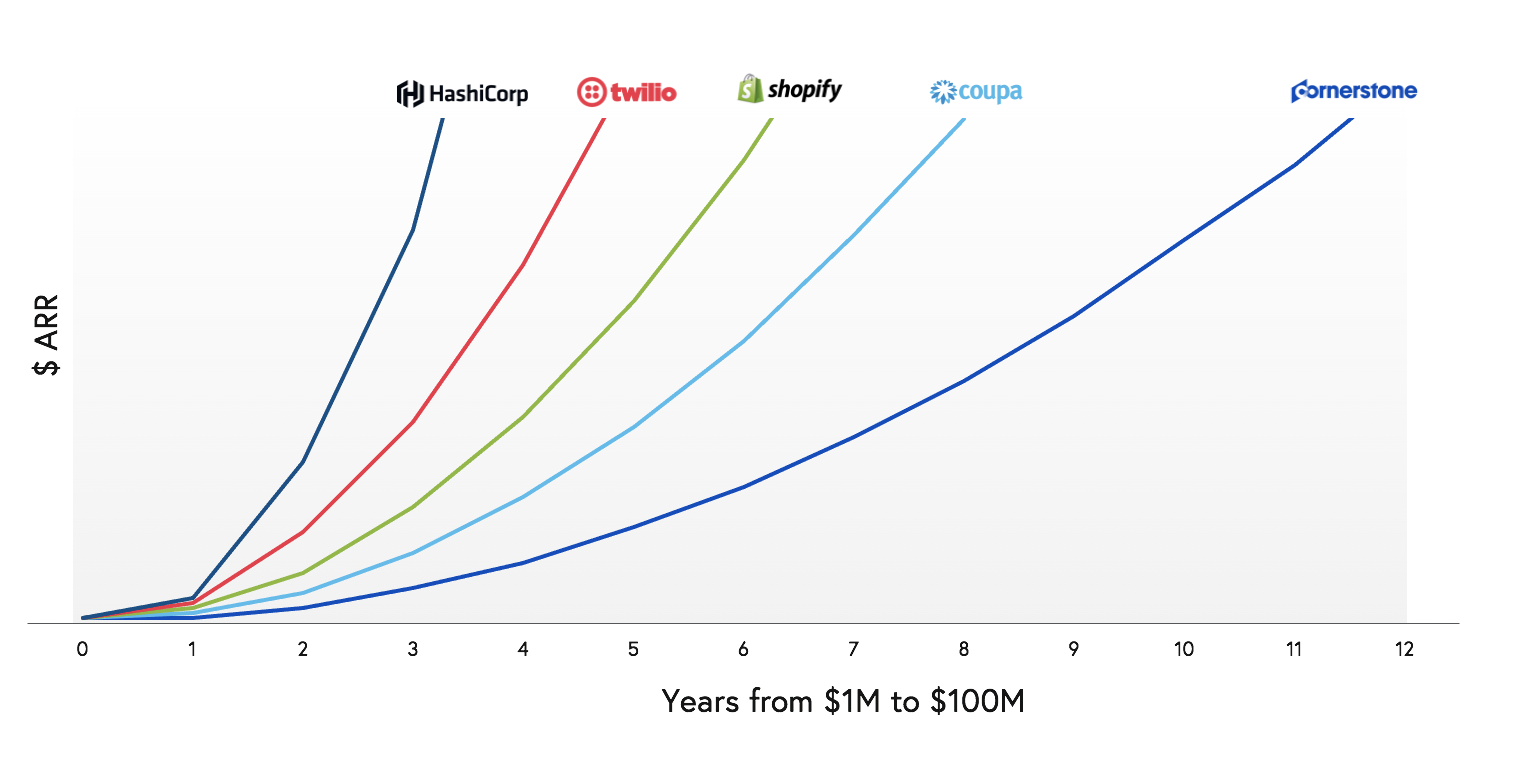
Tactic B: Move upmarket only when the time is right
There’s a critical paradox facing every product-led growth company: while a bottoms-up strategy is instrumental for initial traction, many must ultimately layer in top-down sales to unlock their full potential. Introducing an upmarket motion too early in a startup’s lifecycle can be detrimental, but there is also a real opportunity cost in waiting too long. So how can you tell when the time is right? And who should you look for as a first enterprise sales hire?
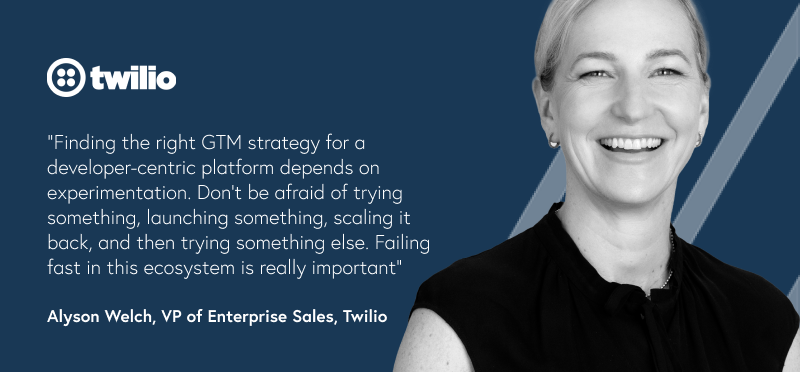
Twilio’s Alyson Welch (VP of Enterprise Sales) has been at the frontlines of this exact situation and provides some practical guidance here:
- Don’t hire ahead of revenue. Only hire your first rep when you hit a milestone where the cost of sale and average deal size justifies an external hire. If you are hiring reps without having the requisite number of leads coming in or vice versa, that is money and time inefficiently spent.
- Hire an evangelist. Beyond hiring based on credentials, experience, or tenure, the most important pattern to try to match when hiring your first sales rep is to look for a clone of the founder in as many ways as possible—an evangelist of the product, but with a quota.
- Balance inbound with outbound. In the early stages of building out your enterprise sales team, most leads will come inbound, but remember to test outbound tactics and refine them.
And remember your best customers that you listened to and scaled with through a bottoms-up motion? They now provide valuable customer references which can make a difference in getting a foot in the door of larger organizations. We’ve now come full circle with initial product-led momentum fueling your sales-led success.
Parting wisdom
The majority of SaaS founders, at one phase or another, will hit a friction point that threatens the acceleration of their startup’s growth. While it may feel daunting to face these challenges along your product-led growth journey, we’ve seen a litany of successful companies overcome similar obstacles with the right tactics, especially as it pertains to monetizing, expanding accounts, and shifting to the enterprise.
Many of our highest-performing portfolio companies with bottom-up growth strategies have scaled to $100 million of ARR in a few short years by identifying their friction points and applying these time-tested methods. What we have laid out are insights derived from developer platforms that also correlate with Bessemer’s Developer Laws, however we see the same patterns across different areas of our portfolio—from vertical SaaS to Fintech. Just as the cloud business model revolutionized the software industry more than two decades ago, we believe the product-led growth approach is a new accelerant that’ll help startups gain more traction, faster than ever before.
How is your business leveraging product-led growth techniques? We’d love to hear from you! Reach out on Twitter (@NextBigTeng, @ethankurz, @BessemerVP) to connect.


